|
Nanuq
2016
Photo Peter
Gallinelli
|
|
|
|
|
Nanuq 2016 : from Qaanaaq to Maniitsoq - Greenland
- Post scriptum
(September 20, 2016)
- The long route
(August 25, 2016)
- Alice in the land of
wonders (September 10, 2016)
- Back to Qaanaaq
(July 11, 2016)
- Moorings Greenland West
Coast (June 25, 2016)
- Passive Igloo - feedback
(June 20, 2016)
- Design With Climate
(June 10, 2016)
- Dreams and reality -
interview (May 30, 2016)
- Snow, at last (May
5, 2016)
- H2O (April
20, 2016)
- En route for the summer
(April 11, 2016)
- Spring (March
30, 2016)
|
|
Post scriptum (September
20, 2016)
Photo above: Greenland, literally the land of green (photo
Peter Gallinelli).
Europe ... we rediscover a luxuriant flora and the moist
sweetness of the atmosphere of the temperate regions; Our
scientific samples have found their way to their respective
laboratories and we are in the process of drawing the conclusions
of the 'passive igloo'.
With the distance, the life we conducted during a year seems
to us more and more to come from a most audacious dream. It
is doubtless an episode of our lives spent in one of the wildest
inhabited places of our planet. But: where men live, life
is possible. And for having lived it we can affirm that so
it is.
We have once again settled to our places in the turbulent
world of civilization that runs, runs ... while the certainty
of another world continues to vibrate in our hearts, where
the caribou roams in compete liberty, the seal relaxes itself
in the sun, man celebrates the present, here and now.
The long route (August
25, 2016)
Long was the descent that was to bring Nanuq and her crew
back to the world of civilisation. We may be proud of having
rallied Nuuk against winds and currents which go up the coast
in the opposite direction ... without motor, damage on the
propeller shaft making our mechanical propulsion unusable.
It is as if the North tended us temptations and uttered threats
to prevent us from leaving. Yes, sometimes the way to go is
easier than return. But, often things are not interesting
because they are easy, but precisely because they are not
...
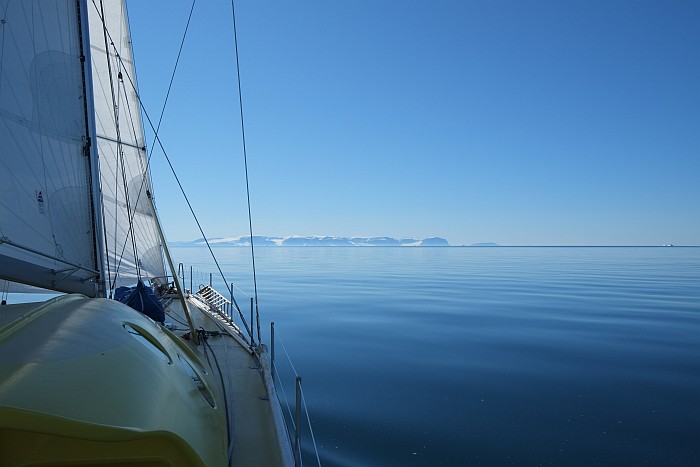
Heading south, Norcumberland island
in the distance - time seems to have stopped (photo Peter
Gallinelli)
Our admiration for the navigators of the past who ventured
into these waters with the sole force of the wind and the
arms is all the greater: we take full measure of the difficulty
of navigating in a region where the maps are incomplete, safe
anchorages are rare, fog is frequent and ice and wind conditions
far from ideal for a sailboat. Still happy that our boat is
comfortable and good sailing, even in slight winds, especially
since we removed the useless propeller that has become an
unnecessary burden. To thrust Nanuq's 20 tons in the absence
of wind we still have the meagre power of the dinghy.

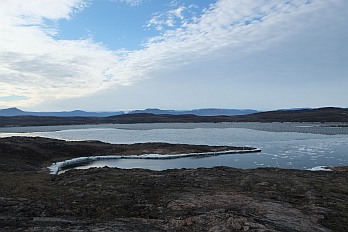
Farewell to our adoptive family in Siorapaluk
- Nanucs Cove, empty (beware of the shoals in the middle!)
(photos Peter Gallinelli)
However, slowness does not compromise our progress or our
optimism, and brings us even closer to the elements. The encounters
with the inhabitants are always as warm and the landscapes
sumptuous, although the fog is particularly tenacious this
year which can be explained by the exceptionally warm water
temperature, at more than 10 ° C where it should approach
zero degrees! The ice melts very quickly and we encounter
only a few bergs en route.
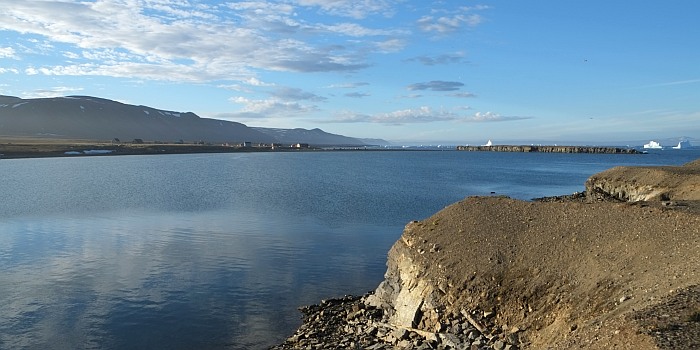
The small bay close to the now abandoned
settlement of Moriusaq 76°45'03N 69°50'55W (photo
Peter Gallinelli)
Siorapaluq, Moriussaq, Kuvdlorssuaq, Upernavik, Umanaq, Qeqertarssuaq,
Ilulissat, Aasiaat, Sisimiut ... known places pass by and
the Arctic summer is coming to an end. The shadows lengthen
and the first gales mark the turn. With the return of the
night we are rewarded with beautiful auroras and rediscover
the stars.
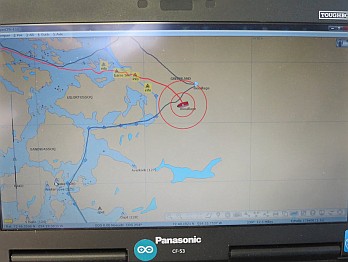
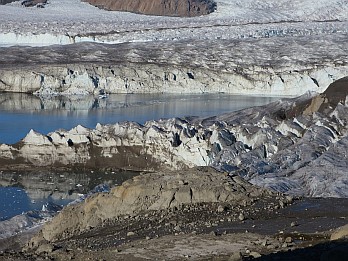
Upernavik Isfjord : sailing on land
... some glaciers have melted as far as 10km inland (photos
Alice Robson)
Nanuq is now ready to spend her third winter in the north
and ice. This time on her own. Already the tundra is coloured
red, orange and bright yellow. The time to fly home to find
our family has arrived. See you next year!
Alice in the land of wonders
(September 10, 2016)
... or the impressions of discovering Greenland:

Bay of Umanak, Nanuq, summer 2016
(photo Alice Robson)
Greenland. Land of ice, wilderness and profound beauty.
Arctic summer with 24 hours of sun. Tranquillity and
solitude. We have seas, mountains, lakes, rivers, icebergs
and glaciers all to ourselves. I experience Icebergs
for the first time, learning their sounds, artistry
and dynamics. The thunder of breaking icebergs is never
far away, the tinkle and fizzing of the bubbles in the
melting ice is everywhere. When the icebergs break,
they roll and turn and dance finding a new balance,
creating new and wonderful patterns, shapes and lines,
almost unbelievable in their finesse and exoticism.
Or they crumble suddenly leaving a flow of floating
ice debris. Alain, man of imagination and vision, sees
animals, birds, dragons, fish, whales, boats, castles
and more around us. They range from the huge to the
tiny, dense to occasional. On the boat, anything bigger
than a modest pumpkin is worthy of avoidance and would
be enough to sink a normal sailing boat. "Nanuq”'s
custom built aluminium hull is strong - we hear the
characteristic rasp of ice scraping along its sides
as we sleep.
To sail with the sunshine on a night watch is a new
pleasure. As we move south and towards autumn, “night”
changes from “the sun is in the north” and
is now when the sun gives a gentle and curving caress
to the horizon. Soon the sun will set, and we will have
twilight, sunset and sunrise, the sun always moving
across, much more than up and down. The change is fast,
by the time we leave we have 5 hours of twilight.
We sail south along the fiords. Every few days there
is a small village or settlement nestled on the shore
with brightly coloured wooden Scandinavian style houses
and a small supermarket that must provide everything
for the long winters here. Around the houses, are drying
fish and seal-meat. Husky sled-dogs sleep outside with
young puppies running loose; the winter sledges are
stacked high. There are no cars, nor roads. Transport
is by boat; mostly very small open fishing boats, with
hugely powerful outboard engines and enough space for
5 or 6 people at most. The locals are friendly, welcoming
and curious. We are invited to Kaffemik, a party for
the village (of 40) celebrating the first day of school
for the son (now 6) of our host. We try caribou, halibut,
muskox, arctic hare, whale fat and whale meat. Alain
is invited to try a specialty: dip a piece of raw caribou
fat in his coffee -- and swallow. Then it is their turn
to inspect our boat, eat chocolate and take home trophies
of our tea bags.
Greenland has less wildlife on show than I imagined.
The sea-birds are modest compared to UK shores. On land
an occasional arctic hare, ptarmigan, and arctic fox
(we never see Caribou). We regularly see seals, though
always afloat. Then there are the occasional, treasured
and humbling, sightings of whales. Huge fast-moving
finbacks by the boat; feeding and diving Humpbacks by
the ice. Across the bay, the tall unmissable spouts
of whales on the move, and a different understanding
of “Tha’ she blows!”.
Greenland is a land of questions and contrasts. It
is both ancient and new, empty and full, barren and
abundant, bare and covered, harsh and delighting. The
colours are subtle and muted and yet deeply vibrant.
A small green plant on the dark rocks, seems more green
than our garden back home. There are bright pockets
of arctic flowers on the low tundra. Berries to be harvested.
Crisp mosses and lichens on the rocks. Time appears
to have a different scale. How old is the ice melting
in the icebergs? How long ago was this newly emerged
glacial landscape carved out? We sail across what once
was a land of ice and is now a new fiord complete with
islands. The ice is retreating faster than the maps
can document. Old, new, fast, slow, beginning, end.
Here it is easy to imagine the origins of our ancestors
and modern worlds. Here there is no illusion of scale
or importance. In such grand nature, we are tiny and
in awe.
More
photos by Alice ... (external link)
A.R.
|
Back to Qaanaaq (July
11, 2016)
There we are, once again moored in front of busy Qaanaaq
(New Thule). We are ready for the sailing season and awaiting
our first crew. Heading South from now on: a strange feeling!
Photo above: melting ice the day of departure from Nanuq's
Cove, 10 days ago. An ice anchor and winches proved efficient
to make our way through...

Leaving 'Nanuq's Cove'... (photo Peter
Gallinelli)
Bye, takussagut!
Moorings Greenland West Coast
(June 25, 2016)
Sailors heading towards the arctic may find a collection
with information on some of the moorings we have been to -
and liked. Follow this link...
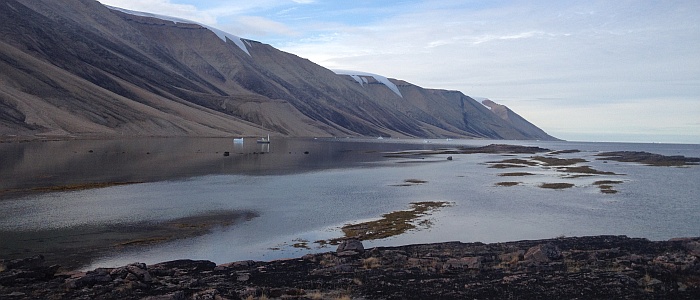
Mooring West of the abandoned village
of Qeqertarsuaq; view to te West (photo Kalle Schmidt)
Have fun!
Carte postale 06 (June 10,
2016)
 cliquez pour zoomer
cliquez pour zoomer |
Juin 2016 : melting ice at 'Nanuq's Cove'
All poscards... here |
Passive Igloo - feedback
(June 20, 2016)
Month of June. Our environment is changing and every day
is different. Temperatures are around 0°C but they feel
to us like summer. According to the locals, the season is
3 weeks earlier than usual. Our vessel slowly transforms from
the 'illu' - the igloo, or house - to the 'umiaq', the boat
that will allow us to sail home one day.
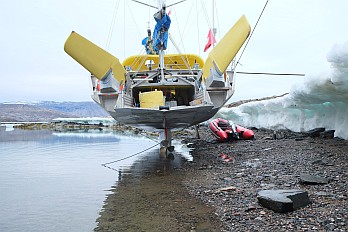
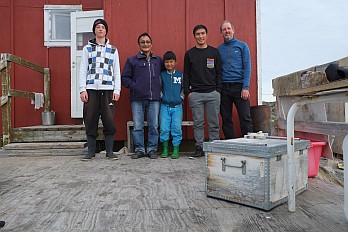
Nanuq,beachning for hull inspection
after the winter - our friends in Qeqertat (photos Peter Gallinelli)
Winter is over. We draw our first conclusion on the
passive igloo project, a laboratory for self
reliant and ecological buildings. And we can affirm
that the initiative is a success.
The passive igloo shows that it is possible
to make buildings close to self sufficient as far
as energy supply is concerned in simple and economical
way, even in severe cold climates.
Of course, there are details that can and should
be improved - there always are (!). Especially, we
were surprised by the lack or absence of Wind that
was supposed to be our main power supply during the
arctic winter. This was unexpected but demonstrated
that a system requiring very little external supply
to perform is also resilient: we were able to get
along never the less.
Not only strategies were tested, but each sub-system
was tested in real conditions to its ultimate limit.
During some periods, when we were completely cut
of from civilisation, the conditions of extreme cold
would not allow any failure. This means that the systems
had to be very reliable. Being a completely passive
system, the most reliable was the thermal insulation.
As such, absolute efficiency proved more important
than reliable supply.
Last, but not least, the expedition had to cope with
a limited budget. This fact made us stick to affordable
solutions only.
It is gratifying when an experiment confirms an
idea. And it is very instructive when they diverge.
Knowledge of reality emerges when ideas meet experience.
|
|
Comparison of fuel consumption of different
housings in Northern Greenland for one winter : 1 barrel
equals 200 litres of fuel, red for heating (excluding
hot water), orange for electricity.
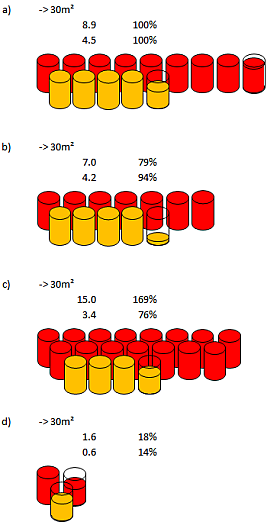 :
:
a) 'traditional' house imported from Denmark
b) high performance house
c) old wooden hut
d) passive igloo (no wind)
Families are big and the houses are small. 2-3 occupants
will occupy roughly 30m² of living surface.
e) a house built to mandatory swiss standards (SIA),
including mandatory living area, in Thule climate ...
frightening!
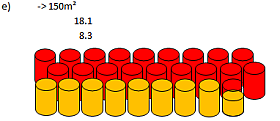
|
Design With Climate
(June 10, 2016)
|
Design With Climate is a qualitative
design assistant tool. It evaluates winter and summer
design strategies as a function of hourly climatic data
of a given station at a clic.
The psychrometric chart method is based on theoretical
work by B.Givoni and M.Milne.
Adaptation to cold and arctic climates and application
development by P.Gallinelli. Enjoy!
More information and download here... |
Dreams and reality
- interview (May 30, 2016)
This is a project sketch I made in 2012 ...
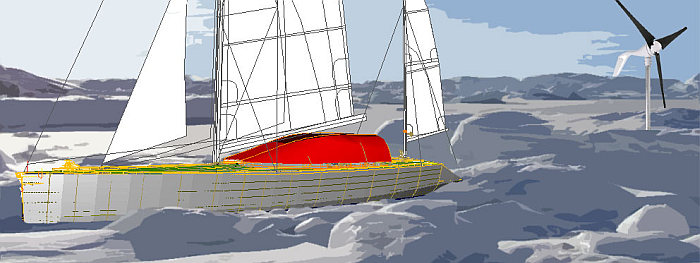
The passive igloo project - project
outline 2012 (Peter Gallinelli)
... and this is a photo taken in May 2016 : amazing!
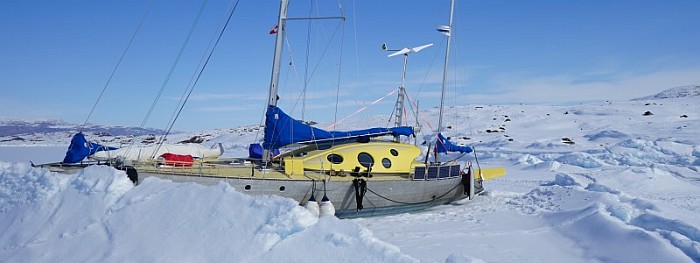
The real passive igloo - end of winter,
Nanuq Greenland 2016 (photo Peter Gallinelli)
Q (Frederic) : Is it crazy to make a project like this?
If you have a dream, it would be crazy not to try to
make it happen, even if it seems out of reach.
Q: How did the idea of this project originate?
Through the wish to make my professional interests converge
with my passion for sailing and the arctic regions - I do
research in building physics and lecture sustainability in
architecture. A long time ago I had a dream where I saw myself
on a yellow sailboat, living on the winter ice somewhere in
the North-West Passage, eating rice and whole grain bread...
Q: In such a project there must be obstacles? How did you
overcome them?
It wasn't easy to make this project happen. There were
many obstacles, the most difficult being financing and time.
It required determination, perseverance and patience. I made
a lot of things myself and I had full support from my family
and many friends who were essential to the success of the
project. The support from our partners was also important.
This assistance was needed to build the 'igloo', the boat
and the project which took several years. It is important
to be surrounded when the task is challenging. But these are
also great opportunities to share. In a way it's like climbing
a mountain: you must think of the next step only, and do it
well.
Q: If there was a message to share, what would it be?
I like the quotation from Philippe Chatel saying 'Make
you dreams devour your life to prevent life to devour your
dreams'. It is important to listen to your dreams. Dreams
are what make the world evolve. Some call it hope... It's
not the easy way. But do we live to go the easy way?
Interview with Frederic Gillet and Peter during a scientific
camp in May 2016.
Postcard 05 (May 07, 2016)
 clic to zoom
clic to zoom |
May 2016 : midnight sun in 'Nanuq's Cove'
77°29.5'N 66°33.5'W
All poscards... here |
Snow, at last (May
5, 2016)

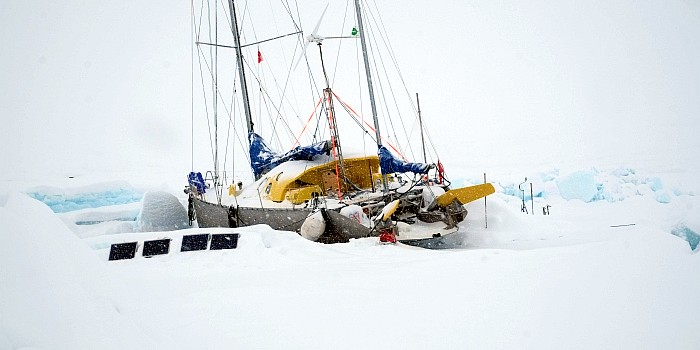
Nanuq in the fresh but warm snow in
springtime (photo Peter Gallinelli)
The sun does no longer set. Day is continous. We have the
impression to live on another planet. The arctic is so different,
so special. Conditions are changing rapidly. Every day is
different and warm air from the South brings the first positive
temperatures since September last year ... and tons of fresh
snow. The snow cover lays heavily on the ice shelf and makes
sea water rise above the ice. The walk to the village takes
twice the usual time and is exhausting. Even our dogs are
tired.

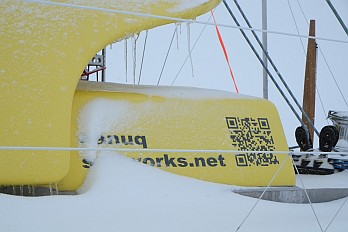
Nanuq in the fresh but warm snow in
springtime (photos Peter Gallinelli)
The ice close to Qaanaaq has begun to break up. Siorapaluk
has open water. The ice at 'Land's end'[1] has disappeared.
2016 is on its way to become a record year for warm temperature.
Progressively we prepare our vessel for the change to come.
We have cleared the deck from the thick snow cover that has
acted as a warm winter blanked, giving us additional protection
from the harsh cold. Although temperatures are between -5°C
and -15°C, the sun heats the exposed surfaces to above
zero temperatures, especially aluminium wich is a good absorber.
We have stowed away our winter clothes that have become too
warm to wear. At noon we can roam outside just dressed in
long johns and a T-shirt.
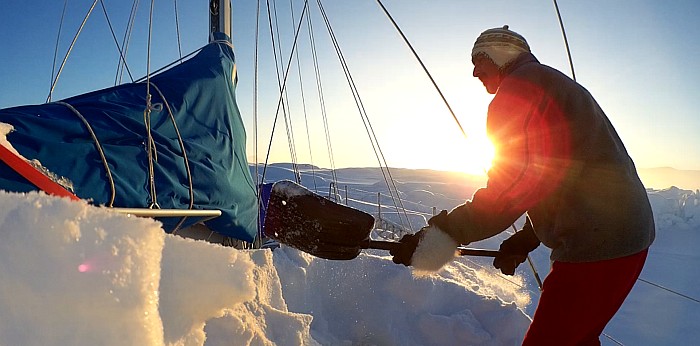
One o'clock am: uncovering Nanuq after
a long and cold winter (photo Peter Gallinelli)
We see the first birds migrating from the south and hear
them chirping in a new language. The rocks that are exposed
to the sun heat up and make the snow melt. The vegetation
below the snow cover has started to grow ... the arctic summer
will be short, but intense.
This is also the tourists' season. Visitors from a different
countries come to visit us, three groups of five. We enjoy
the visits and share our experience for the time of a cup
of tea. The usual question is "... and you never get
bored?".
Preparations of our boat and the setup of the winter camp
occupied most of the autumn. But since our camp is installed
and everything is performing to our expectations, including
the scientific work, we have spare time to follow our ideas,
interests, dreams or being with others ... the Greenlanders
say 'winter is a social time'. Our time is devoted to discoveries,
developments, thoughts, ideas, projects, reading, writing,
creating ... with the time it requires to accomplish each.
It is also a time for discovering our natural environment,
others and ourselves. We learn to let things happen. Without
doubt, we never get bored.
Enventually our visitor leave with the wish to come back.
We have started to grow seeds. We rediscover the wonderful
taste of fresh food. Of course it's symbolic, but it means
a lot to us.
Twilight now calculates sun, moon, twilight and
solar flux, a way to celebrate daylight and the sun that make
life on Earth possible and the moon that animates nature with
its cycles. Cycles of nature are an important feature when
living in the wild... follow this link.

Sun and moon for Nanuq's Cove, May 2016
(screen shot 'Twilight')

Visibility of the moon for Nanuq's Cove,
May 2016 (screen shot 'Twilight')
We ask ourselves: when will the ice let us leave? This will
be our last big challenge.
Bai- takussagut.
Peter & crew
[1] Land's end is how we call the western tip of 'our' island.
There are strong tidal currents.
Postcard 04 (April 28, 2016)
 clic
to zoom clic
to zoom |
April 2016 : springtime snow storm over
'Nanuq's Cove'
77°29.5'N 66°33.5'W
All poscards... here |
H2O (April
20, 2016)

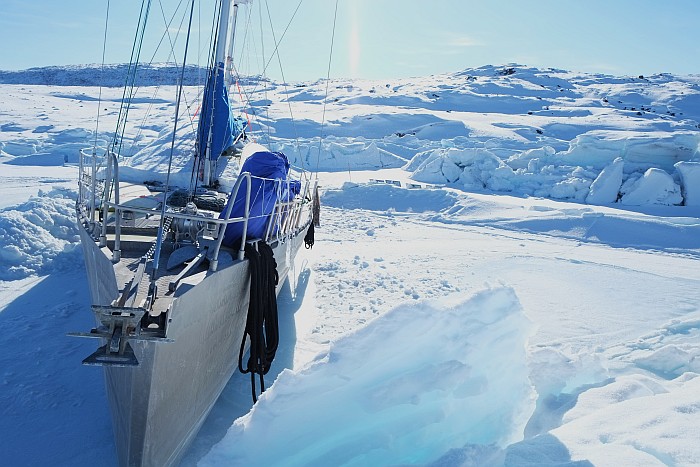
Arctic spring (photo Peter Gallinelli)
Liquid
Whist water in the arctic is abundant, it is either seawater
or frozen. So one needs to make some effort to get something
to drink. And one drinks amazing amounts of water due to the
loss through respiration of the extremely dry air. Liquid
water can be found below the ice of the many frozen lakes,
but requires to drill a hole, anexhausting job even with the
help of an ice drill since ice is 1.8 metres thick by now.
To collect the 70 litres of fresh water we use in a week
takes two hours of time, including the 2 km walk to the lake,
drilling the hole and filling up our jerrycanes. And this
has to be done be it -0°C or -40°C. The comfort of
a water tub is far away. But it is often difficult to apreciate
things to their real value if you dont have to do an effort
to get them. We apreciate our fresh water to its real value.
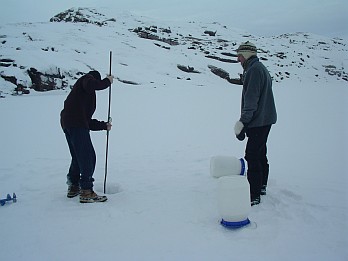
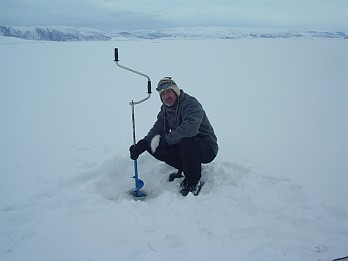
Drilling through almost 2m ice to collect
fresh water in a nearby lake
(photos Barbara Gallinelli)
The locals melt ice from icebergs. The waters is the purest
one can imagine. The ice is broken into chunks and made to
melt in a plastic container inside the well heated dwellings.
Water for washing com from the nearby lake. In the north one
will find neither pressurized water nor evacuation. They will
only be available in towns where reliable electricity is available.
Failure of the electric heating will result in immediate freezing
and damage to any water network.
Solid
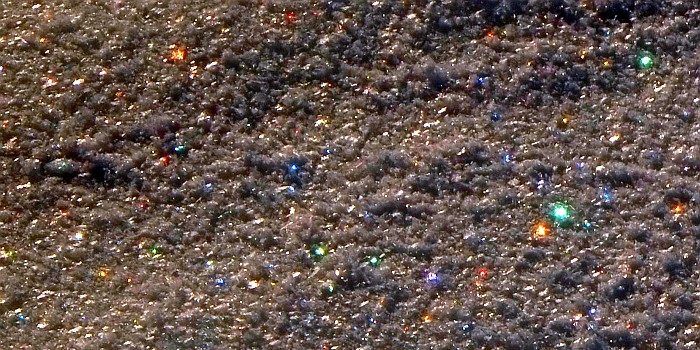
Snow covered by precious stones ...
(photo Peter Gallinelli)
The snow is covered with ice crystals that are so pure that
sunlight is split into thousands of coulours. We have the
impression of walking on a carpet covered with precious stones.
Having a closeup, we discover that it is not an imression...
Vapour
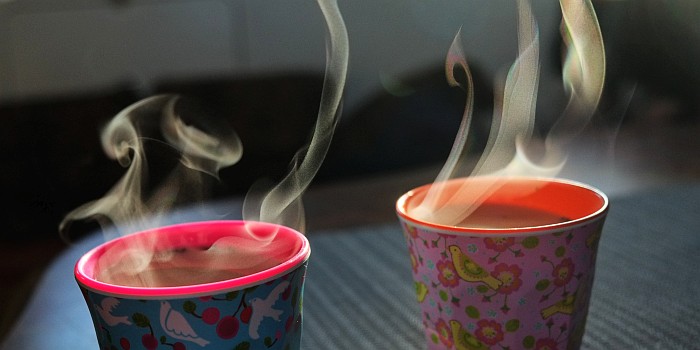
Tea time on Nanuq (photo Peter Gallinelli)
When observing the vapour above a hot cup of tea one will
notice that time flows at a different pace. We live at the
rythm of nature: sun, moon, seasons, the sky, life, ourselves.
In two days time the sun will no longer set ... before August
21st. Things change progressively. This is one of the very
specific features of this place on earth.
En route for the
summer (April 11, 2016)

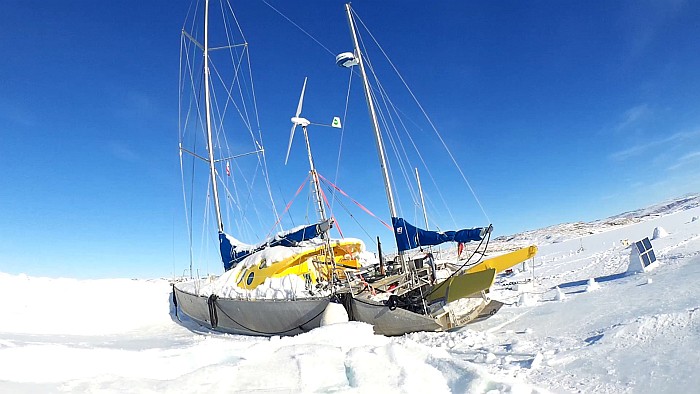
Spring camp under bright sunshine (photo
Jakob Gallinelli)
Officially winter is over. But temperature is still well
below zero. We expect the change to be fast. And we have begun
to plan the summer season to come. The agenda is becoming
ever more precise, even though ice and weather will be last
to decide. This is proper of the arctic. Greenlanders would
call it 'imaqa' - maybe ...
Imaqa is likely to be the most used word in Greenland.
Imaqa, specially when you plan to travel about. 'When
will we leave?'. Often the answer will be imaqa:
tomorrw, another day... The weather, the ice, the overwhelming
nature make this imaqa necessary. Be it by dog sledge,
boat or airplane, nature must be taken into acount, always.
In the north our limits are clearly defined. Nobody would
be stupid enough to transgress.
Far from being a constraint, it brings us closer to essentials
and lets us aprehend our real place on earth. That there is
no distinction between man and environment. We are just a
part of it.
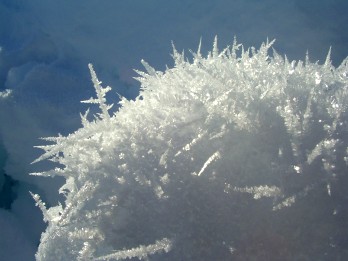
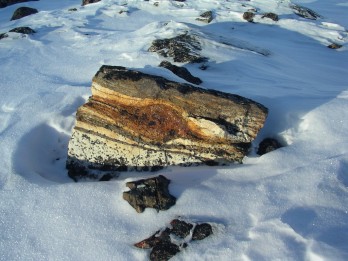
Ice critals and rocks (photos Barbara
Gallinelli)
Life in nature is spectacular. Each day is different. Each
moment is unique. Everything changes constantly. Including
ourselves. This is life. Life is everywhere. One can feel
it.
We compose with nature, as good as possible. And a sailboat
is ideal to get even closer to nature. To make progress we
need to listen to the whisper of nature, sense the slightest
breeze, tide, current, ... Life on a boat is a great school
towards simplicity, self reliance, responability, cohabitation,
teamwork, friendship... rarely practiced in such a complete
way elsewhere. For us it the beginning of an prenticeship,
also a conquest. Thats already quite much.
As by now, we are looking forward to our vessel to transform
to more than an illu - igloo, the house : a boat. We
imagine our return back to civilisation, inavoidable, due in
time to lecture for the new academic year. Of course imaqa
cannot be avoided. But since the years of sailing in moste remote
places, we have always been able to honour our agenda. Good
planning ist part of the story. But then it is mostly about
making the best with conditions and letting a big place to welcome
the unpredictable.
Details here...
Keep in touch!
Spring (March
30, 2016)
We celebrate Easter. Its the springtime equinox. Sun has
risen above the Pole and daylight reaches our location from
the other side of the Earth, amplified by the bright ice and
snow cover. We rediscover our environment under a new light.
During the dark winter months our eyes had become used to
the darkness. Now they have to re-adapt to bright sunlight,
even whilst sleeping. Right now there is no more dark night.
Beginning in a couple of weeks the sun will no longer set
at all... The change is impressive. The light and clearness
of the atmosphere give the impression that everything is within
reach. We organize more and more excursions.
Temperatures are still far below zero, but we do no longer
feel the cold due to our apprehension of lightness, sunshine,
acclimatization and the perspective that the coldest periods
are now past. Whilst the so called windchill factor
gives indication to feeling of cold associated to wind, we
have introduced our own sun-heat factor taking into
account the effect of sun and calm conditions, a phenomena
you will experience when sitting in the sunshine on a sheltered
altitude terrace.
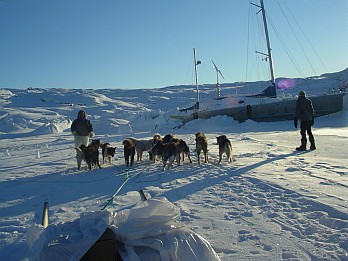
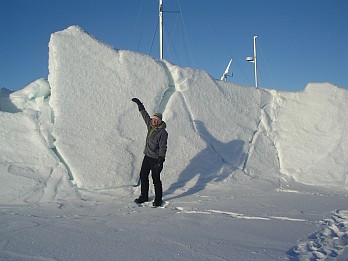
Arrival at Nanuq's Cove by sledge. The
pressure of the ice shelf crushes ice. (photos Barbara Gallinelli)
Even though temperatures vary between -20 and -30°C,
the end of winter is rather mild. The other day, when returning
from the settlement, two of our dogs broke through the ice !
The spot is known to be fragile due to the strong tidal streams.
But nobody expected the ice to be that fragile, even our local
guide was surprised. Whilst one season is too short to make
any conclusions on climate change or global warming, the local
inhabitants are amused and intrigued when scientist introduce
them to climate change. Traditional cultures living in harmony
with their natural environment sense what the city dweller
is unable to feel. The people of the North are aware of the
profound change of the fragile arctic ecosystem since more
than a generation...
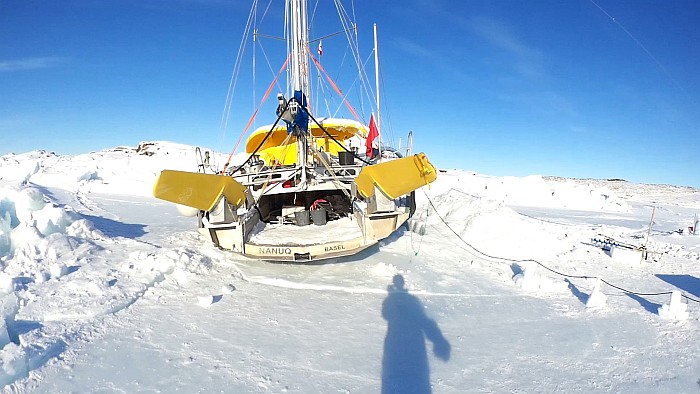 Nanuq
with lifted rudders, safe from ice (video extract Jakob Gallinelli) Nanuq
with lifted rudders, safe from ice (video extract Jakob Gallinelli)
By now, the windows that are exposed to the direct sunshine
are warm and efficiently contribute to the cabin heating.
We observe the first drops of melting water dripping down
the warm hull - aluminum plates are perfect heat absorbers.
Nevertheless, harsh conditions and complications are far
from over. The powerful compression from the ice have lifted
Nanuq out of her comfortable cradle and make her heel 7 degrees
to port. We have to use grip cloth to prevent dishes and glasses
from sliding down the table. And we maintain a trench on one
side of the hull to ease the propulsion system from the pressure.
The sissa
is still giving us surprises…
In parallel, the scientific program goes on. The monitoring
equipments keep an eye on the passive igloo's performance,
measure numerous climatic parameters, the sea ice and PCB
concentrations ... while we set out to test breathing equipment
for sports in extreme cold. It is gratifying when an experiment
confirms an idea. And it is very instructive when they diverge.
Knowledge of reality emerges when ideas meet experience.
And as such, the passive igloo is an fantastic laboratory.
The exploration of new paradigms becomes possible "by
making time available to think and create freely and by providing
resources and places to experiment new techniques of living,
by creating laboratories that are less polluted by interferences
and dynamic interactions [with the established system…]"
- "A new paradigm is much more likely to be successful
when one makes the real experience." [1]
Keep in touch...
[1] Isabelle Fremeaux, John Jordan (free translation)
 : older articles ...
: older articles ...
- Winter : 77°30'
66°34W : crew 2 : 3 months
- Here comes the Sun (March 3, 2016)
- Twilight (March 3, 2016)
- News from the ice shelf (February 22nd,
2016)
- Seqineq : the sun rises (February 18, 2016)
- Shisha (February 12, 2016)
- Good news (February 1, 2016)
- Voyage to Qaanaaq (January 26, 2016)
- Greenlandic word list (January 22, 2016)
- Happy New Year (January 15, 2016)
|